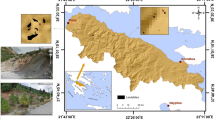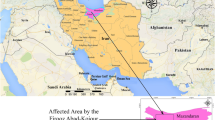Abstract
This study presents an adaptive neuro-fuzzy inference system (ANFIS) approach performed to estimate the number of adverse events where the dependent variables are adverse events leading to four types of variables: number of people killed, wounded, hijacked and total number of adverse events. Fourteen infrastructure development projects were selected based on allocated budgets values at different time periods, population density, and previous month adverse event numbers selected as independent variables. Firstly, number of independent variables was reduced by using ANFIS input selection approach. Then, several ANFIS models were performed and investigated for Afghanistan and the whole country divided into seven regions for analysis purposes. Performances of models were assessed and compared based on the mean absolute errors. The difference between observed and estimated value was also calculated within \({\pm }1\) range with values around 90 %. We included multiple linear regression (MLR) model results to assess the predictive power of the ANFIS approach, in comparison to a traditional statistical approach. When the model accuracy was calculated according to the performance metrics, ANFIS showed greater predictive accuracy than MLR analysis, as indicated by experimental results. As a result of this study, we conclude that ANFIS is able to estimate the occurrence of adverse events according to economical infrastructure development project data.





Similar content being viewed by others
Abbreviations
- \(p_i, q_i\), and \(r_i\) :
-
Consequent parameters of training process
- \(O_{i,j}\) :
-
Output of node i in layer j
- \(w_{i}\) :
-
Weight of the \(i\hbox {th}\) rule
- y :
-
Dependent variable
- \(X_{k}\) :
-
Independent variables
- \(b_{k}\) :
-
Coefficients of regression
- c :
-
Constant value of y
- \(e_{i}\) :
-
Prediction error
- N :
-
Total number of validation records
- \(P_{i}\) :
-
Predicted values
- \(O_{i}\) :
-
Observed values
References
Adnan MM, Sarkheyli A, Zain AM, Haron H (2015) Fuzzy logic for modeling machining process: a review. Artif Intell Rev 43(3):345–379
Beck RA (2003) Remote sensing and GIS as counterterrorism tools in the Afghanistan war: a case study of the Zhawar Kili region. Prof Geogr 55(2):170–179
Berrebi C, Lakdawalla D (2007) How does terrorism risk vary across space and time? An analysis based on the Israeli experience. Def Peace Econ 18(2):113–131
Bhattacharjee Y (2007) Pentagon asks academics for help in understanding its enemies. Science 316(5824):534–535
Brown D, Dalton J, Hoyle H (2004) Spatial forecast methods for terrorist events in urban environments. In: Intelligence and security informatics, pp 426-435
Cakit E, Karwowski W (2015) Assessing the relationship between economic factors and adverse events in an active war theater using fuzzy inference system approach. Int J Mach Learn Comput 5(3):252
Clancy J, Crossett C (2007) Measuring effectiveness in irregular warfare. Parameters 37(2):88
Çakıt E, Karwowski W, Bozkurt H, Ahram T, Thompson W, Mikusinski P, Lee G (2014) Investigating the relationship between adverse events and infrastructure development in an active war theater using soft computing techniques. Appl Soft Comput 25:204–214
Çakıt E, Karwowski W (2015a) Understanding patterns of infrastructure development in the active war theater of Afghanistan over the period 2002–2010. Proced Manuf 3:3876–3882
Çakıt E, Karwowski W (2015b) Fuzzy inference modeling with the help of fuzzy clustering for predicting the occurrence of adverse events in an active theater of war. Appl Artif Intell 29(10):945–961
Çakit E, Durgun B, Cetik O (2015) A neural network approach for assessing the relationship between grip strength and hand anthropometry. Neural Network World 25(6):603
Demirci S, Suen IS (2007) Spatial pattern analysis of pkk-kongra gel terror incidents in Turkey: 2003–2004. Underst Respond Terror Phenom Multi-Dimens Perspect 21:153
Drapeau MD, Mignone BK (2007) Culture, conflict, and\(\ldots \) climate? Science 316(5831):1564–1564
Faustino CP, Novaes CP, Pinheiro CAM, Carpinteiro OA (2014) Improving the performance of fuzzy rules-based forecasters through application of FCM algorithm. Artif Intell Rev 41(2):287–300
Gupta RA, Kumar R, Bansal AK (2010) Artificial intelligence applications in permanent magnet brushless DC motor drives. Artif Intell Rev 33(3):175–186
Hahn HA (2013) The conundrum of verification and validation of social science-based models. Proced Comput Sci 16:878–887
Jang JSR (1993) ANFIS: adaptive-network-based fuzzy inference system. IEEE Trans Syst Man Cybern 23(5):665–685
Jang JSR, Sun CT, Mizutani E (1997) Neuro-fuzzy and soft computing : a computational approach to learning and machine intelligence. Prentice Hall, Upper Saddle River
Jang JS (1996) Input selection for ANFIS learning. In: Proceedings of the fifth IEEE international conference on fuzzy systems, vol 2, pp 1493–1499
Johnson SD, Braithwaite E (2009) Spatio-temporal modeling of insurgency in Iraq. In: Freilich JD, Newman GR (eds) Reducing terrorism through situational crime prevention: crime prevention studies, vol 25. Criminal Justice Press, Monsey, pp 9–32
LaFree G, Dugan L, Xie M, Piyusha Singh P (2012) Spatial and temporal patterns of terrorist attacks by ETA 1970 to 2007. J Quant Criminol 28(1):1–29
Medina RM, Siebeneck LK, Hepner GF (2011) A geographic information systems (GIS) analysis of spatiotemporal patterns of terrorist incidents in Iraq 2004–2009. Stud Confl Terror 34(11):862–882
Nauck D, Klawonn F, Kruse R (1997) Foundations of neuro-fuzzy systems. Wiley, New York
Numrich SK, Tolk A (2010) Challenges for human, social, cultural, and behavioral modeling. SCS M&S Magazine (January), 1–9
Open Source Center (OSC) (2009, April 30). Afghanistan-geospatial analysis reveal patterns in terrorist incidents 2004–2008. http://www.fas.org/irp/dni/osc/afghan-geospat.pdf. Accessed3 May 2012
Rusnak DM, Kennedy LW, Eldivan IS, Caplan JM (2012) Analyzing terrorism using spatial analysis techniques: a case study of Turkish cities. In: Lum C, Kennedy LW (eds) Evidence-based counterterrorism policy. Springer, New York, pp 167–185
Schmorrow D, Nicholson D (2011) Advances in cross-cultural decision making. Chapter 38, CRC Press, Boca Raton, pp 374–384
Shroder J (2005) Remote sensing and GIS as counterterrorism tools in the Afghanistan war: reality, plus the results of media hyperbole. Prof Geogr 57(4):592–597
Siebeneck LK, Medina RM, Yamada I, Hepner GF (2009) Spatial and temporal analyses of terrorist incidents in Iraq, 2004–2006. Stud Confl Terror 32:591–610
Stanton J (2007) Evolutionary cognitive neuroscience: dual use discipline for understanding and managing complexity and altering warfare. In: International studies association conference, Portugal. http://ssrn.com/abstract=1946864
The 2013 Human Development Report (2013) The rise of the south: human progress in a diverse world. HDRO (Human Development Report Office), United Nations Development Programme, pp 144–147. Accessed 20 May 2013
Webb J, Cutter SL (2009) The geography of U.S. terrorist incidents, 1970–2004. Terror Political Violence 21:428–449
Willmott CJ, Matsuura K (2005) Advantages of the mean absolute error (MAE) over the root mean square error (RMSE) in assessing average model performance. Clim Res 30(1):79
Acknowledgments
The authors are grateful for the support of the Office of Naval Research (ONR) under Grant No. 1052339 and the helpful guidance of ONR Program Management. The authors also gratefully acknowledge the Editor and anonymous reviewers for their constructive and helpful comments.
Author information
Authors and Affiliations
Corresponding author
Rights and permissions
About this article
Cite this article
Çakıt, E., Karwowski, W. Predicting the occurrence of adverse events using an adaptive neuro-fuzzy inference system (ANFIS) approach with the help of ANFIS input selection. Artif Intell Rev 48, 139–155 (2017). https://doi.org/10.1007/s10462-016-9497-3
Published:
Issue Date:
DOI: https://doi.org/10.1007/s10462-016-9497-3




